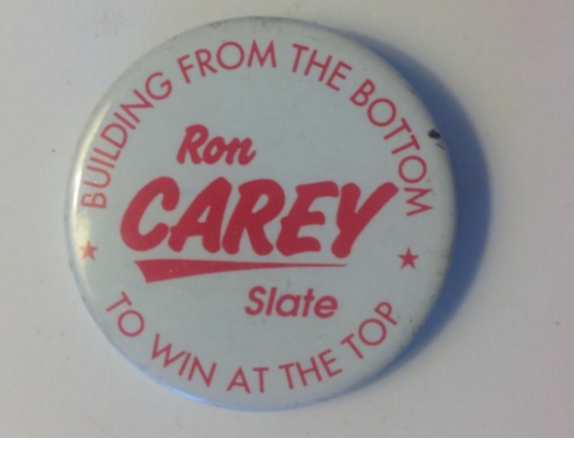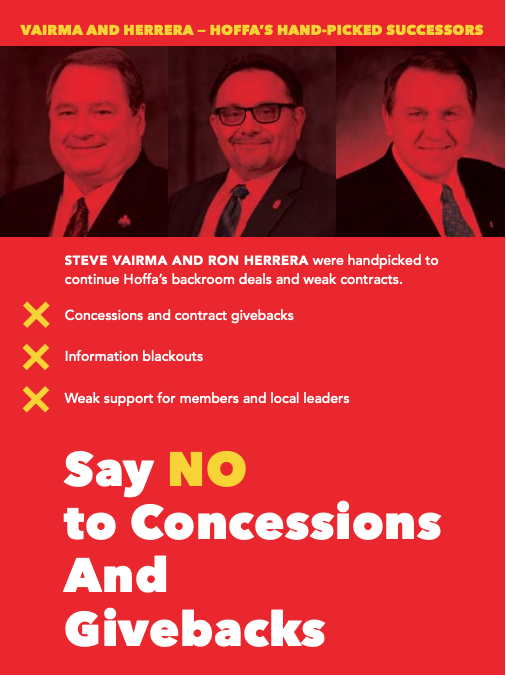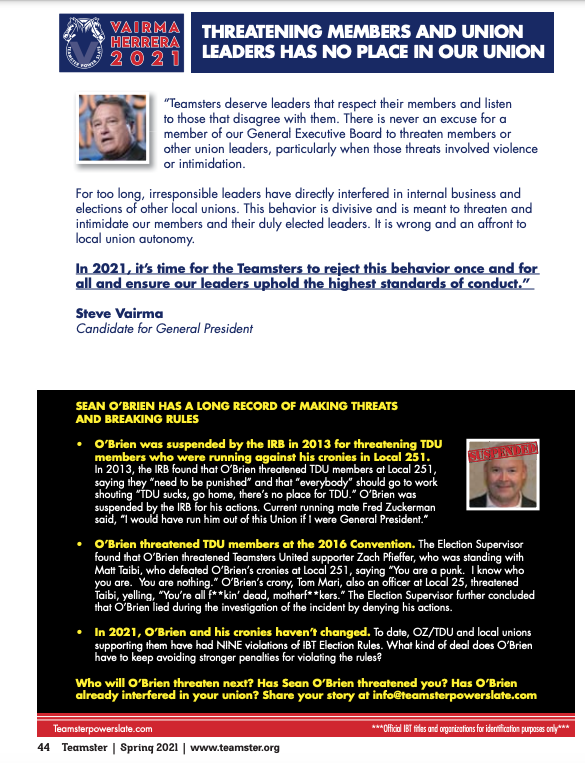What’s at stake at the Teamsters’ convention
New direction for the end of the Hoffa era?

The 2021 Teamsters convention will take place June 22-25. It is the first convention in 25 years where James P. Hoffa will not be nominated for the highest office in the union. While many consider the convention historic because it will signal the end of an era, it will be a highly scripted, online event—large sections will appear as an infomercial for the outgoing Hoffa administration.
The future of the Teamsters is already the subject of heated debate, including between two major slates of candidates for union leadership. Sean O’Brien and Fred Zuckerman-led Teamsters United appears to have the lead in the race for convention delegates, over the Teamster Power slate led by Steve Vairma, who has received Hoffa’s endorsement.
We can also expect publicity stunts from the outgoing administration. Hoffa may use his farewell speech to announce that the Teamsters are ready to take on Amazon. Past conventions saw similar pledges to organize FedEx Ground and XPO and have little to nothing to show for it.
Teamsters United are hoping for a showdown with the lame-duck Hoffa administration over a series of constitutional reforms. It is hard to see how this happens when an online convention will be more tightly controlled.
Not unexpectedly, Hoffa has stacked convention committee assignments against Teamsters United supporters despite protests from Sean O’Brien. Ironically, O’Brien was a Hoffa supporter in 2016, and his thuggish treatment of Teamsters United delegates then led to formal charges against him. The shoe is on the other foot now.
Of course, the Teamsters would not be the Teamsters unless dissenters were harassed and threatened. Surrounded by a sea of red-vested Hoffa delegates, the small number of anti-Hoffa delegates were physically and verbally abused through the years. This time physical abuse will be replaced with keyboard censorship.
The Teamsters are one of the few major unions that have the membership directly elect the top officers of their union. The most important part of the convention will be nomination of candidates from the two major slates to succeed Hoffa and the rest of the leadership.
However, membership turnout has been on a steady decline for over a decade. Despite this, in 2016 when voter turnout crashed to 15 percent of the 1.4 million member union, Hoffa came within a few thousand votes of defeat.
The 2016 results signaled that it was time for Hoffa to leave the stage. When he announced his retirement last year, he boasted, “I think I would win again.” Empty boasting is one of the features of the Hoffa era. Picking a successor was also a fraught process for Hoffa during the last year until he chose Vairma.
Ballots will be mailed out to the membership in October and counted a month later. Will Teamsters turnout in larger numbers after a year of pandemic-induced horrors in the workplace? That is anybody’s guess, right now.
Whatever the turnout, all eyes will be on the Teamsters. It is the most important union election this year.
The largest logistics union
The Teamsters remain the largest logistics union in North America despite a declining membership. National organizing has been a disaster, especially in freight where they were once dominant and where they made their name as a fighting union.
The “jewel in the crown” of the Teamsters is United Parcel Service (UPS) with over 250,000 members, a literal union within a union. The Teamsters also represent railroad engineers, track workers on all the major railroads, and major freight carriers like Yellow and ABF. The Teamsters have not flexed their muscles in these industries in a long time, however.
The 1997 UPS strike led by the Teamsters first and only reform leader Ron Carey was the last time the union shut down a major part of the national economy. The 1997 strike was the most important industrial struggle in a generation and it was victorious.
 Few working Teamsters today walked the picket lines during those three weeks in August 1997, that was nearly a quarter of a century ago. Carey paid the price for leading such an important strike when he was driven out of the union by the federal government.
Few working Teamsters today walked the picket lines during those three weeks in August 1997, that was nearly a quarter of a century ago. Carey paid the price for leading such an important strike when he was driven out of the union by the federal government.
Hoffa’s longevity in office was made possible because of the federal government attack on Ron Carey and a relatively unified conservative union bureaucracy that backed him. Hoffa was never a personally popular leader. He has few tangible achievements to tout except the ability to win elections.
He won five during the previous two decades, but he has also been steadily losing support among union officials for years. Hoffa was nearly defeated in 2016 by Fred Zuckerman of Louisville, Kentucky, who was previously his carhaul director.
Teamsters United
Like in 2016, Zuckerman will again be running on an anti-Hoffa, Teamsters United slate. This time Zuckerman will run for General Secretary-Treasurer, the junior position in the leadership, alongside Sean O’Brien, International Vice-president and head of Boston Local 25, who will run for the all-powerful position of General President.
O’Brien was a notorious figure in the Teamsters—his thuggish support for Hoffa was well known before their falling out. Now he is running for office as a reformer, which has surprised more many. Few believe O’Brien has really changed despite proclaiming, “I’m not that guy anymore.”

The O’Brien and Zuckerman-led slate is also known as the OZ slate. OZ has the reform tag because of the endorsement of Teamsters for a Democratic Union (TDU), the legendary reform group that has moved very far away from its radical roots. Sean O’Brien once took great pleasure in tormenting TDU members.
Even before facing disciplinary charges in 2016, Hoffa suspended O’Brien for threatening union members in 2013 during a local union election in Providence, RI, where a TDU-backed slate was running. TDU now embraces him, which has also surprised many.
The OZ slate have positioned themselves as reformers against Hoffa loyalists led by Vairma. Both slates, however, are dominated by candidates made up of former Hoffa loyalists.
Teamster Power
Like O’Brien, the leader of the Teamster Power slate, Steve Vairma, is a longtime Hoffa ally. Hoffa appointed him warehouse director in 2012, and Vairma has stuck by him as the old Hoffa coalition has cracked and splintered.
Rumor has it that Vairma was not Hoffa’s first choice for successor but his third after Kevin Moore of Detroit and Terry Hancock of Chicago were scratched as potential successors. Both Moore and Hancock carry heavy political baggage. Hancock, however, recently joined the Vairma slate.
Part of the appeal of Vairma may be his anonymity. Few people know him outside of a small number of officials in the bloated Teamster bureaucracy. But, that does not mean that he does not have a record.

Vairma was elected Secretary-Treasurer of Teamsters Local 455 in 1996 and since 2007 has led Joint Council 3, both are based in Denver, Colorado. Local 455 and the joint council represent a wide variety of industries and workers far beyond the trucking industry that most people think of when they think of the Teamsters.
In 2018, Vairma won no friends at UPS when he supported Hoffa imposing an unpopular national contract at UPS Teamsters.
Race, bigotry, and the Teamsters
The most controversial issue during Vairma’s leadership, however, was when he discriminated against members of his own local union. In December 2015, 150 Somali-American workers at the massive Cargill meatpacking plant in Fort Morgan, Colorado walked off the job. They were protesting the refusal of the agribusiness giant to honor their Muslim workers right to pray on the job, which they had previously done.
Cargill fired them, and the workers responded by filing suit against the company for religious discrimination with Equal Employment Opportunity Commission (EEOC). Twenty also filed suit against the Teamsters with the EEOC.
The EEOC reached a settlement with 138 former workers with Cargill for $1.6 million but also reached a settlement with Vairma’s Local 455 for $150,000 in August 2017. The EEOC reported:
[Our] investigation found reasonable cause to believe that Local 455 denied its members, who worked at the Cargill Meat Solutions plant in Fort Morgan, fair union representation for failing to advocate for them, and subjecting them to retaliation and a hostile work environment because of their race, national origin and Muslim religion, all in violation of Title VII of the Civil Rights Act of 1964.
The Counter, an investigative magazine covering the food industry, summed it all up:
A union doesn’t really work if it doesn’t represent everyone, and the EEOC findings don’t exactly make Teamsters 455 look like the embodiment of the inclusivity principles the labor movement was built on.
While the OZ slate has tried to capitalize on this huge failure of Vairma’s leadership with a campaign video, O’Brien has problems with race, religion, and sexism of his own. The Top Chef scandal involving O’Brien’s men threatened to engulf the entire labor movement.
As I previously explained :
The popular cooking series on Bravo is hosted by former model Padma Lakshmi. On June 10, 2014, Top Chef started filming at the Steel & Rye restaurant in Milton, a suburb of Boston, without union labor. Instead of focusing on the use of nonunion labor, an explosion of racist, sexist, and Islamophobic slurs took place, including the threat, “That’s the pretty one. We want to smash her face in.”
The activities of O’Brien’s crew were almost entirely recorded by cell phone. Charges of racism were at first dismissed by O’Brien as “fiction at best,” but he was forced to eat his words after the recording of his men surfaced.
The federal trial that followed exonerated O’Brien’s men from violation of the Hobbs Act but did not exonerate the local union from a reputation for racism and sexism.
Local 25 was considered an outcast union until Massachusetts Republican Governor Charlie Baker welcomed O’Brien’s endorsement while running for reelection in 2018—a strange way for a union to be rehabilitated.
O’Brien also has a long record of doing Hoffa’s bidding at UPS, including the selling of concessions. A scathing indictment of O’Brien’s record was once provided by his current running mate Fred Zuckerman, having previously referred to him as an example of “depravity” in the Hoffa administration.
Debating debates
The election campaign has not yet generated much enthusiasm outside the two slates and their immediate supporters. For the Left it is notable that, despite TDU backing O’Brien, decades after the founding of the modern Teamsters reform movement neither candidate for General President nor a sizeable number of slate candidates have any connection to that movement.
Turnout for the election is on everyone’s mind, considering the historic low turnout in 2016. Widespread cynicism about internal Teamster politics—including its racial politics—is one factor, another is the poor performance of the union during the pandemic and the deadly summer heat waves.
Neither Teamsters United nor Teamster Power slate have made much of a case for members to turn out in the election. Pledge card drives by the Teamsters United appear to be their solution to voter turnout. It is doubtful that this alone will raise the number of voters.
One way to draw larger numbers of Teamsters into discussion about the future of the union would be to expand the number of debates beyond the number officially authorized by the Teamsters constitution.
Yet, scorn was heaped on Philadelphia Teamsters leader Richard Hooker, once hailed by TDU as part of a new wave of Black leadership, when he invited O’Brien and Vairma to debate in his local union. Ken Paff, national organizer of TDU since 1978, derided Hooker’s invitation in a Facebook discussion, “this is not the way to organize debates.”
During past elections, the debates sponsored by the Teamster election officer had their usefulness but were staid affairs where a moderator fielded questions from journalists with a labor background. Hoffa ducked out on these on every occasion, and this year Vairma appears reluctant, though he has accepted Hooker’s invitation. O’Brien wants debates but under the tight control of the election officer.
There are a total of 54 candidates from both slates vying for the top spots in the Teamsters. This is surely enough people to debate in front of the members across the U.S., Canada, and Puerto Rico? What are they afraid of?
At the same time, the sordid records of O’Brien and Vairma have not gone unnoticed. It has also not escaped notice that for a union that is two-thirds Black and Latino, three of the four candidates for General President and General Secretary-Treasurer are white.
This is the tip of the iceberg when it comes to discussions of racism in the Teamsters. In 2019, it was reported that there are slightly more than four hundred locals in the Teamsters, and only 17 were led by African-Americans. Only one member of the 24-member General Executive Board is African-American.
None of this has escaped the attention of Chris Silvera, longest serving local Teamsters officer and former head of the National Black Caucus, who ran a short lived campaign for General President earlier this year.
Hooker has been conducting long Facebook interviews with Silvera addressing issues of race and the influence of far right ideas among the Teamsters membership, an issue even Hoffa admitted was serious.
Silvera directly challenged O’Brien on these issues. He pointed out that there are no Black officers or union representatives in O’Brien’s Local 25, and then asked, “Who do you think the Trump Teamsters will vote for?” He also forthrightly asked about the “strange marriage of TDU and O’Brien.”
Hooker’s interviews with Silvera are garnering a larger number of viewers each week, and have tapped into a widespread feeling of dissatisfaction with what is on offer in the Teamsters election, especially among African-American Teamsters.
While Silvera has too many positive things to say about the Vairma slate, the issues he raises are important and he does it in a refreshing manner.
Teamsters looking for answers to these questions are unlikely to find them at the convention or from the current crop of candidates for the top officers. The Teamsters have suffered stagnation and decline for over twenty years. The rise of non-union logistics giants like Amazon are no longer something looming on the horizon but are long established facts.
Can Hoffa’s managed decline of the union be reversed? Right now, that is a difficult question to answer positively.
For further reading:
Where Are the Teamsters Going? By Joe Allen, December 13, 2019, New Politics.
A 2021 Teamster Election Primer: Gangsters, Reformers, and Socialists in the Teamsters. A Reading List by Joe Allen, Medium.
Categories
We want to hear what you think. Contact us at editors@tempestmag.org. And if you've enjoyed what you've read, please consider donating to support our work:
DonateJoe Allen View All
Joe Allen is a long-time labor activist and writer. His latest book is The Package King: A Rank and File History of UPS.
